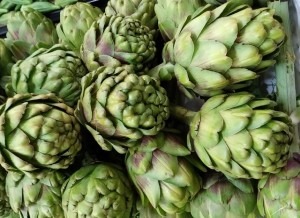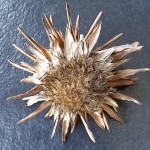There are two unrelated plants called artichoke – Globe Artichokes – Cynara scolymus and Jerusalem Artichokes – Helianthus tuberosus. Different parts of the two plants are eaten. The Globe Artichoke is a member of the Asteraceae family, is a thistle and the flower bud is eaten. The Jerusalem Artichoke is a sunflower and the tuber is the edible part. As well as providing food, globe artichokes are attractive plants in the garden.
They originated in Mediterranean regions and Central Asia so will grow in many parts of Australia. Because they are extremely hardy and perennial, they are a useful addition to gardens where you want minimal chemical inputs. Warmer sub-tropical and tropical climates result in decreased flower size.
Growing to 1 – 1.5 metres in height and width, they make a stately feature and because they are perennial, a spot needs to be chosen that allows full advantage to be taken of the appearance of their graceful arching leaves. Buds grow on the ends of long flower stalks and may be green, bronze or purple according to the variety.
Planting schedule
Warm: August – November
Temperate: August – November
Cool to cold: September – November
Position
They prefer a sunny spot with plenty of space and well-drained soil. Because they produce 4 – 6 flower heads in their first year and 10 – 12 in the second year if grown from an existing plant, you will only need 1 or 2 plants per adult in the house. If growing from seed, flowers won’t form until the second year. They can be grown in pots but make sure the pot is about 1 metre wide and at least 30 cm deep. Raised beds are perfect for them.
Soil and fertilising
They love – like most veggies – a rich, well-drained soil. If you see their outer leaves drooping, it will be because of waterlogging in winter or drying out in hot summers. Plenty of compost in the soil is important in preventing both extremes as it helps drainage in winter and retains moisture in summer. So making sure the soil is prepared properly at planting time is vital for successful growth in subsequent years.
Flowering and harvesting
 The first buds appear in early spring and continue through to early summer. Flower buds should be harvested before they open and when the stem below the bud is still pliable. That is, they should be in the shape of a globe (that’s where they get their name from!). To pick the buds use a sharp knife to cut the stem leaving a few centimetres of stalk attached.
The first buds appear in early spring and continue through to early summer. Flower buds should be harvested before they open and when the stem below the bud is still pliable. That is, they should be in the shape of a globe (that’s where they get their name from!). To pick the buds use a sharp knife to cut the stem leaving a few centimetres of stalk attached.
Pests and diseases
Crown rot can be an issue in a humid climate
Propagation
They may be grown from seed, shoots or suckers. Plants can be kept for several years and each year suckers will form at the base of the stems. They should be cut back to 30cm high in autumn. In winter they are pruned with the four strongest shoots left to flower the following spring.
 Use as decoration
Use as decoration
If flower heads are left on the plant and allowed to dry they are attractive additions to dried floral arrangements.
Cooking
Method 1
Cut about 2cm off the top of the artichoke head and remove the top cm or so of all the ‘leaves’. Also remove excess stem, leaving 1 – 2 cm. Gently open out the ‘leaves’ a little and rinse in cold water. Place the whole head in a pot of water to which you have added some lemon juice and perhaps some garlic and a herb like bay leaf. Bring to boil, and simmer for about 30 minutes until the outer ‘leaves’ can be easily removed. Drain the head.
Both the lower portions of the outer leaves, the ‘heart’ and the top cm or so of the stem can be eaten. Try dipping the lower portions of the leaves in mayonnaise, or a vinaigrette prepared from oil, lemon juice with finely chopped herbs like parsley, then scraping them off with your teeth.
When the lower leaves have been removed, scoop out the fine, hairy portion which is inedible, and then the remaining heart can be eaten with the dip.
Method 2
http://www.davidlebovitz.com/2013/05/how-to-prepare-and-cook-artichokes/
Ingredients
6 – 8 artichoke heads
2 tablespoons olive oil
3 cloves garlic, peeled and thinly sliced
salt
red pepper flakes or black pepper
1/4 cup (60 ml) water or dry white wine
1 tablespoon fresh lemon juice
2 tablespoons finely chopped flat leaf parsley
Remove all but 2 cm of the artichoke stem and 3 cm of the head above where the stem meets the lower ‘leaves’. Pull or cut off the lower leaves until the central portion is revealed. Scoop out the hairy centre of what is left and remove anything around the top of the stem that is tough so that you are left with the ‘heart’. Place the ‘hearts’ in water with slices of lemon and some bay leaves.
Add oil to a pan with the garlic and heat slowly.
At the same time, working relatively quickly, drain the artichokes, towel dry them, and slice them about 1 cm thick or cut into wedges.
When the garlic starts to sizzle, add the artichoke slices, tossing them a few times, then season with salt and a generous pinch of red pepper flakes or a few turns of black pepper.
Cook for about 5 minutes, stirring occasionally, then add the water or wine and the lemon juice, and cover. Reduce the heat to low and cook for about 12 minutes or so, removing the lid and stirring a few times, until the artichokes are tender. They’re done when you can poke a paring knife into one and it meets no resistance.
Stir in the parsley. Cook for another minute or so to get rid of any excess liquid, then remove from heat. If you want to brown the artichokes further, add more olive oil and keep cooking the artichokes, stirring infrequently, until browned.
References
Blazey, C. Varkulevicus, J. (2006) The Australian Fruit and Vegetable Garden. The Diggers Club.
McFarlane A. (2001, reprinted 2008) Organic Vegetable Gardening. Australian Broadcasting Corporation.
Related Articles:
Garden Journaling – Slow down to tune in.
As we move through the year and our gardens evolve, there's something magical about documenting the journey. Garden journaling is an art that enables…
The Importance of building soil health for a biodeverse, productive garden
Creating a thriving garden that not only sustains itself but also contributes to the broader ecosystem requires more than just sunlight and water.…




